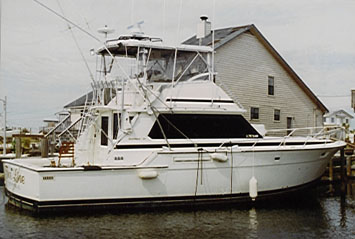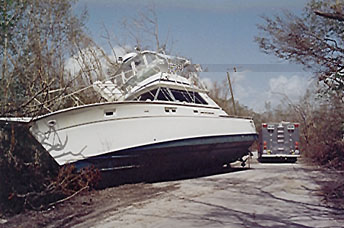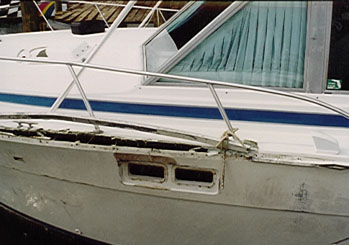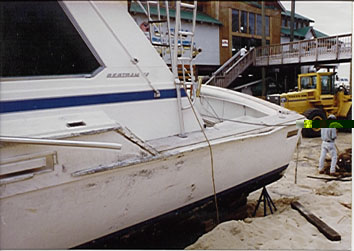Bertram 42 Convertible
by David Pascoe

This example is a hurricane Opal survivor.
The 42C is the little brother of the immensely popular 46 Convertible, which is nearly identical in every way except scale. The 42 was slightly less popular, and therefore there are fewer of them, perhaps because the price differential with the 46 was not all that much. Like a lot of builders, they end up with two models that compete with each other. But its a real gem of a boat if you don't mind cabin spaces that are not as well laid out as they should be. As a fishing platform it is nearly ideal, and makes a decent southern cruising boat as well. There are lots of them that are never fished.
As with the 46, the 42 was also offered in a motor yacht model (shown on the introduction page), both of which were a total bust because they didn't fool anyone as to what they are: an attempt to make a motor yacht out of a hull designed for a sport fisherman. Few builders are ever successful doing this.
This model was first introduced in 1973, and along with the 46C, is one of the longest production yachts ever built, finally discontinued in 1987. Fourteen years of non-stop production has to tell you something about this boat when the average production run is probably more like two years. Originally coming in at 34,000 lbs., she grew in weight over the years to 40,000 lbs. but engine power increased considerably also. The original 8V71's were a bit slow, but these engines are going to last a long time, too. The 6V92's move her along at respectable speeds, although fuel consumption is not so respectable.
In our view, the 42C offers one of the best values around in a used boat of its class. Not only is it well built, but the overall design achieves its purpose of creating a first rate fishing platform with decent amenities. With a 14-10 beam and a moderately sized deck house, interior space is adequate. The bridge layout is good, and the cockpit, having fished this one myself, is plenty big with a full Murray Brothers chair. Throw in a tackle center on both sides of the door and it cramps up a bit because the bridge ladder stands off the bulkhead by 30".
What makes the 42 an overall better performer are the fact that the hull vee is less than the 46, plus the fact that she'll hold the same size engines. That means that she isn't hobbled by underpowered engines and they are comparatively much faster boats, a feature which nearly everyone likes. Nor are they as fuel hoggy. Power options run the gamut, all the way from 6-71's, 8V71's, 6V92's and the Cummins 903. You really need 800 HP to drive this boat, so we don't recommend anything less than that. With that much power, not many folks will be dissatisfied with her performance.
What you will be dissatisfied with are (1) wood cockpits on earlier models, (2) generators under leaky cockpit decks that turn into a ball of rust, (3) wood tackle centers, (4) those horrible aluminum rub rails that corrode badly, and (5) an engine room that is badly cramped.
Beyond that, this a great boat. The photo above is a dolled up job that looks just super by just adding a small feature stripe, tinted windows and painting the window frames black, plus a little gold striping. If she looks to be sitting a little funny, that's because this photo was taken just a few days after hurricane Opal. Other boats around her were badly damaged or destroyed, but total damage to this one was $22,000. Below is another 42 that the 160 MPH winds and waves of Andrew pushed through and took down nearly 100 yards of mangrove forest. And mangrove wood is darn tough stuff.
After seeing so many of these boats bashed and battered, we know how they're built, and we can tell you that they really are tough cookies. These hull laminates are no thicker than anybody else's, but it is the engineering expertise - often utterly lacking in so many others - that makes the difference. These hulls are plain old woven roving construction and hold up better than all the exotic materials you hear about put together. When you hear builders touting the latest and greatest high tech stuff, we say HOOEY! And we'll be pleased to show you the proof, because its contained right here on the pages of this web site. That's why, over and over again, we show you pictures of busted up boats. The only way to test 'em is to break 'em, and that's what storms do.

This one traveled through 100 yards of mangrove forest before coming to rest on this road.


This 42C took an unbelievable beating at the hands of Opal. It smashed through the waterfront restaurant you see in the background and ended up in a heap with other boats, most of which were destroyed, against a concrete bulkhead. It took such heavy impacts that the engines were knocked off the mounts and the entire interior was broken apart. But the hull was never breached except at the rail seen at top. She's back in service again as though nothing had ever happened.
In the photo showing the boat sitting on the roadway, most of the bottom strakes were torn off. The props and rudders are completely mangled. With the weight of the boat sitting on them, were they pushed up through the bottom and did it fill with water? Nope. No water entered the hull.
There aren't a lot of 15-20 year old boats that are really worth spending some money on, but the 42C definitely is. With prices in the low $100's, putting 50-100k into one of these can net you a nearly new boat at half the price. And one that will continue to look good and not deteriorate at a rate that breaks the bank.
See also featured article
MARLIN MONROE Bertram 42 Convertible.
 Visit davidpascoe.com for his power boat books
Visit davidpascoe.com for his power boat books 














David Pascoe is a second generation marine surveyor in his family who began his surveying career at age 16 as an apprentice in 1965 as the era of wooden boats was drawing to a close.
Certified by the National Association of Marine Surveyors in 1972, he has conducted over 5,000 pre purchase surveys in addition to having conducted hundreds of boating accident investigations, including fires, sinkings, hull failures and machinery failure analysis.
Over forty years of knowledge and experience are brought to bear in following books. David Pascoe is the author of:
In addition to readers in the United States, boaters and boat industry professionals worldwide from nearly 80 countries have purchased David Pascoe's books, since introduction of his first book in 2001.
In 2012, David Pascoe has retired from marine surveying business at age 65.
On November 23rd, 2018, David Pascoe has passed away at age 71.
Biography - Long version